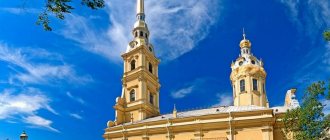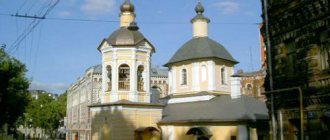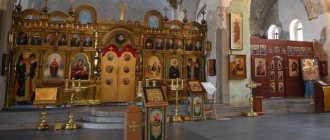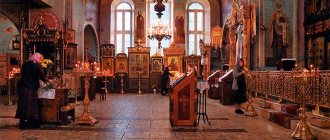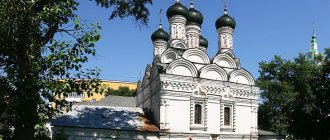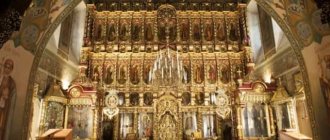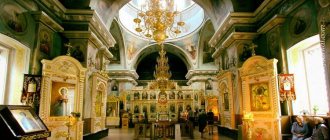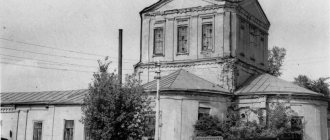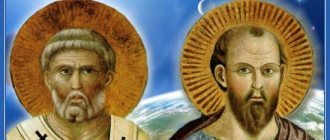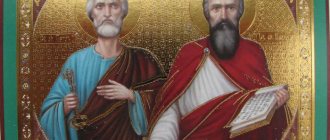In the very center of Moscow, not far from the place where Petropavlovsky Lane intersects with Yauzsky Boulevard, is located the Temple of Peter and Paul - the Serbian Compound in Moscow. Unlike many other Moscow churches, it has never been closed: from the time of its construction to the present day, and even during Soviet times. During the years of persecution of the church, the temple was a place of refuge not only for the clergy, but also for famous shrines transferred here for preservation.
Notes[ | ]
- "On Kulizhki"
- ↑ 1 2
History of the temple Archived copy dated September 23, 2009 on the Wayback Machine - article from the official website - Alexandrova T. L., Suzdaltseva T. V.
Passing Russia: Stories of the Metropolitan. - Hegumen Kirill (Sakharov).
For simplicity, the Lord revealed a lot to him / Dubinkin S.L., comp. - Live by trusting in God. Schema-abbot Rafail (Shishkov). - M.: Danilov Monastery, 2021. - P. 40-42. — 224 p. — ISBN 978-5-89101-693-4. - ↑ 1 2
Metochion of the Serbian Orthodox Church
(unspecified)
. Access date: March 9, 2013. - Transfer of farmsteads to autocephalous Orthodox Churches // Journal of the Moscow Patriarchate. - No. 8. - 1948. (inaccessible link)
- Metochion of the Serbian Orthodox Church (unspecified)
(inaccessible link). Access date: March 9, 2013. Archived April 23, 2013. - Moravik Bishop Antonije (Panteliћ) accepted his doctoral dissertation | Diocese of Backa (unspecified)
.
eparhijabacka.info
(June 13, 2019). - Bishop Anthony of Moravica: The Serbian courtyard is a bridge between two Churches.
- Clergy (undefined)
. serbskoe-podvorie.ru. Date accessed: May 31, 2021. - Shrines of the temple (undefined)
. serbskoe-podvorie.ru. Date accessed: May 31, 2021.
Shrines[ | ]
- Bogolyubskaya Moscow miraculous icon of the Blessed Virgin Mary,
- Icon of St. Nicholas the Wonderworker depicting the transfer of relics,
- Icon of St. Nicholas the Wonderworker with a particle of the relics of St. Neil of Stolobensky in a panagia,
- Icon of the Mother of God “Kazan”,
- Icon of the Mother of God “The Sign”,
- Icon of the Holy Chief Apostles Peter and Paul,
- Icon of the Most Holy Theotokos “Three-Handed”,
- Icon of St. Simeon the Myrrh-Streaming with a piece of healing vine,
- The Savior Not Made by Hands is the image of our Lord and Savior Jesus Christ,
- Icon of the Most Holy Theotokos “Kazan” with forthcoming angels,
- 36 pieces of relics of saints in the altar cross,
- Ark with particles of relics: 1. Cross of the Lord, 2. St. Ignatius the God-Bearer, 3. St. Apostle. Matthew, 4. St. Nicholas the Wonderworker, 5. St. Martyr. George the Victorious, 6. Holy Martyr Princess Lyudmila of Bohemia, 7. Venerable Macarius the Great, 8. St. Tikhon Patriarch of Moscow, 9. St. Athanasius of Kovrov, 10. St. Demetrius of Rostov, 11. St. Theophan the Recluse, 12. St. Ignatius Brianchaninov, 13. St. Myrrh-Bearer Mary Magdalene, 14. Holy Prince Lazar of Serbia, 15. St. Nicholas of Serbia [11].
Rector of the Serbian Compound
Archimandrite Anthony (Pantelic), representing the Serbian Orthodox Church under the Patriarch of Moscow and All Rus', was appointed rector of the Church of Peter and Paul in October 2002.
He was born in the city of Valjevo on July 23, 1970. He took monastic vows while studying in 1988 at the Theological Seminary of the Three Saints. In 1995 he graduated with honors from the Theological Academy in Moscow. In 2006, in Belgrade, he was elevated to the rank of Bishop of Moravić. He is a participant in various scientific conferences and television theological discussions. In 2008 he became a Doctor of Theological Sciences. Writes articles and books of theological content. He was awarded several high church awards for outstanding services. Bishop Anthony still serves in Moscow today.
Temple life today
Over the course of several years, the parishioners, led by the rector, restored and improved the church, opened a Sunday school for Serbian and Russian children, created a church choir, and provided all possible assistance to the Serbs who found themselves in a difficult situation. Students from Serbia who study in theological schools in Russia receive special support here.
Divine services in the Serbian Compound are held every day, a solemn meal is held on major patronal holidays.
There are also unique Shrines here. The Bogolyubskaya Icon of the Mother of God is her revered copy of the 18th century. This image is miraculous; in front of it, many people were healed of the plague. Parishioners brought it to the Church of Peter and Paul in the 30s, when they began to demolish the Kitai-Gorod wall where it was located.
During the existence of the Compound, many pieces of relics and images of saints revered in Serbia appeared here. For example, the miraculous image of St. Simeon the Myrrh-Streaming from the Hilandar Monastery with a piece of grapevine, helping childless spouses give birth to a child.
Today, the Serbian Compound in Moscow is an established Russian-Serbian community, where two Orthodox traditions - the Serbian and Russian people - come together, enrich and complement each other.
CALENDAR
Wooden Church of St. App. Peter and Paul in the Basmanny Captain's Settlement was founded in 1692 at the request of the steward and lieutenant colonel I.F. Bashev. In 1695, the wooden church was listed as newly built and taxed from the courtyards of Basmannaya Sloboda. By 1702, there were 114 households in the church parish. In 1705, work began on the construction of a stone church. The wooden church was still functioning during the work, but nothing is known about its further fate. It should be noted that the reigning Emperor Peter I at that time actively contributed to the founding of churches in honor of his heavenly patron in Azov, Bryansk, Petrozavodsk, Poltava; the construction of St. Petersburg also began with the foundation of the wooden church of St. Peter and Paul.
Stone Church of St. App. Peter and Paul in Moscow was built according to the drawing of Peter I (“according to the drawing sent from the Sovereign’s village of Preobrazhenskoye”) with 2 thousand rubles granted by him. It is noteworthy that in total Peter I made eight drawings of future churches. Seven of them were built in St. Petersburg, and only one in Moscow (all eight drawings are kept in the repository of St. Isaac's Cathedral in St. Petersburg). We also note that at the end of the 17th - beginning of the 18th centuries. New trends have emerged in Russian architecture: especially close cultural and trade relations have developed between Russia and Holland - Peter I made his first trip abroad there. Peter brought many ideas from Holland, including architectural ones. Like the Sukharev Tower, the prototype of which was the Amsterdam City Hall, the Church of St. App. Peter and Paul became the embodiment of one of them.
From the very beginning, the work on the construction of the Church of St. App. Peter and Paul in Basmannaya Sloboda was entrusted to a brigade consisting of 19 serfs from the Yaroslavl province. These were “registered masons,” that is, professional builders registered with the state. The landowners regularly released “masons” to work on the “sovereign’s building.” The names of some of these 19: Andrei Kondratiev, Alexei Vasiliev, Ivan Yakovlev, Konon Nefediev, Philip Vasiliev are known from correspondence with the Ingermanland Chancellery, located in St. Petersburg. The correspondence mentions royal decrees (the earliest dated May 26, 1705), according to which “it was ordered in the Kapitanskaya and Novobasmannaya Sloboda, which is behind the Myasnitsky Gate, near the church stone building, which the church is being built according to a drawing sent from the Sovereign village of Preobrazhenskoye, the Supreme Apostle Peter and Paul, to be a mason for the Yaroslavl district of various landowners ... until the completion of the church, and for other matters from that building those masons were not ordered...”
In 1708, an antimension was issued for the consecration of the throne in the lower church. It was built in honor of St. Nicholas the Wonderworker (in the personal poll book of 1722, the “Church of Peter and Paul, in the Kapitanskaya and Novobasmannaya Sloboda, is mentioned, under it is the lower church of St. Nicholas the Wonderworker, made of stone”).
In 1714, construction of the temple continued. There is a contract agreement concluded in May 1714 by the priest and church elder with the Yaroslavl and Kostroma peasant masons, who “contracted to build an addition to the previous stone structure at that church.” In all likelihood, most of the work was completed during the summer construction season. But further circumstances did not allow the construction of the temple to be completed.
On October 9, 1714, Peter I issued a decree banning stone construction in Moscow in connection with the transfer of the capital to St. Petersburg and the need for its rapid development. Church of St. App. Peter and Paul was on the list of Moscow buildings whose construction was suspended.
Three years later, in 1717, the headman and parishioners of the church reported to the Governing Senate that the church building was almost completed (only the spire that completed the temple and the arches above the porches were missing). But since stone construction in Moscow was prohibited, they asked the Senate to allow the construction to be completed: “Last 1714, according to the Tsar’s Majesty’s personal decree and according to the drawing submitted by His Majesty’s own hand, we were ordered ... to build a church behind the Mesnitsky Gate, behind Zemlyanoy Gorod, which is Kopitanskaya and Novobasmannaya Sloboda, which was previously in that place in the name of the Saints Apostle Peter and Paul, and this church according to the drawing from His Majesty, both the lower and the upper, were built, and at the same time imperfectly: at the top there is a spitzer and on the sides there are no vaults over the porches, which is why this church is in complete ruin, and according to His Tsar’s Majesty’s decree, it is forbidden to build a stone structure in Moscow, and for this reason they will not allow that church to be completed without a decree sent from Your Excellency.” In response to the request, a Senate decree was sent to Moscow for permission to complete the construction: “... the stone church in the name of the Saints Apostle Peter and Paul, if it is planned to build a stone structure in addition to the butte, - to complete the construction...”.
In 1719 the church building was completed. The temple turned out to be two-tiered, with an open arched gallery in the lower tier and a walkway on the upper. Around the church there was a graveyard surrounded by a fence.
In July 1720, an iconostasis was ordered for the upper church, about which a contract record has been preserved. For the “carved iconostasis work” they hired “the princess and Grand Duchess Ekaterina Alekseevna (sister of Peter I, by that time deceased), the rector Trofim Romanov, son of Zherin, and the quitrent peasant of the Kolyazin monastery, the rector Andrei Gavrilov, son of Ushakov.” They undertook to “build carpentry and carved iconostasis in that church according to their design, namely: royal doors and a canopy of carved grass, and instead of pillars there are carved fruits...”. Also, make carved brackets and cornices in the “festive belt, and in the apostolic belt and in the prophetic belt there are also carvings instead of pillars..., and on top of those belts - a crucifix and with the accompanying ones, carved in three faces in the same carpentry,” and, in addition, arrange carved choirs and pulpit.
In May 1737, the church was damaged as a result of one of the devastating fires in Moscow, which was a terrible and constant disaster for the residents of the city with wooden buildings. This time, more than 11 monasteries, 102 churches, more than 2.5 thousand households, and over 486 shops burned down. Church of St. App. Peter and Paul suffered less damage than other shrines: the railings, locker and stairs on the bell tower burned down, and the wooden fence around the church burned out. After restoration work by the middle of the 18th century. In Novobasmannaya Sloboda, an architectural complex has developed, consisting of a temple and a bell tower, topped with spiers and connected by an open white stone staircase leading to the upper temple and to the second tier of the bell tower.
In 1770, priest Alexey Ioannov with the parish people and investors petitioned the Governing Synod to build a chapel. They complained that in winter in the upper church of St. App. Peter and Paul, “early services are corrected with considerable difficulty, and they rarely occur due to frosts and blizzards.” “To correct the early services in the winter,” they asked to build a chapel in the porch at the lower church of St. Nicholas. The dean of the Sretensky Forty, the Trinity Church, Priest John Ignatiev, and the Spasskaya Church in Pushkari, Priest Stefan Vasilyev, examined the place for the new chapel “whether there would be oppression and darkness in that porch” and found it convenient. After which Archbishop Ambrose gave permission to build a new chapel in the lower church in the name of the Nativity of the Blessed Virgin Mary. It was built south of the Church of St. Nicholas the Wonderworker, at the western doors. At the same time, it was supposed to “make a new window and a bright door opposite it” for better lighting. In 1772, the new chapel of the Nativity of the Blessed Virgin Mary was consecrated by Archimandrite Nikon of the Sretensky Monastery.
The territory on which the Church of St. stood. App. Peter and Paul, retained the ancient suburban structure and was occupied by highly elongated building blocks, separated by alleys parallel to Novaya Basmannaya Street. The block in which the church was located was divided into two parts by a longitudinal lane. By the 1770s the longitudinal lane became part of the philistine courtyards and remained on church land as a passage through the churchyard. The territory of the church with the graveyard and the clergy yards was already located within the boundaries of modern numbers 11 on Novaya Basmannaya Street and 6 on Ryazansky Lane. The five courtyards of the church clergy (priest, deacon, sexton, sexton and mallow maker) were areas stretched from the church graveyard to the alley. Wooden residential buildings were oriented with their main end facades towards the church. In the depths of the courtyards there were wooden outbuildings and gardens.
According to the “clergy register” for 1775 - a reporting statement annually sent by the priest to the Spiritual Consistory - in total, 391 males and the same number of females lived in the Peter and Paul parish of the Sretensky Forty. Among the parishioners who signed the statement were eminent citizens: “Dowager Countess Ekaterina Ivanovna Shuvalova, Chief General Vasily Ivanovich Chulkov, Dowager General Marfa Vasilievna Balk, Brigadier Prince Vladimir Borisovich Golitsyn, Colonel Alexey Andreevich Dumashev.” Some of them: A. I. Shiryaeva, M. V. Balk, S. A. Demidova, E. S. Gendrikova, E. I. Shuvalova, had their own home churches, which were part of the parish of the Church of Sts. App. Peter and Paul.
In 1812, during the Napoleonic invasion, more than half of the 300 Moscow churches were damaged by fire. Church of St. App. Peter and Paul on Novaya Basmannaya was plundered and was listed among those burned. At the Red Gate, the French made a shooting target out of church images. The enemy burned the wooden houses of the priest and deacon located on church land. In 1813, among 15 other Moscow churches, the Peter and Paul Church received 1,500 rubles from funds donated by the Kostroma nobility “to repair churches destroyed by the enemy.” The money was used "to repair the roof on the refectory and the bell tower, as well as the stairs leading to the upper church."
After the fire of 1812, according to the “projected” plan of the city of Moscow, the area was subject to urban planning regulation. Modern Basmanny Lane was supposed to be “straightened” by cutting off the church territory. The settlement of the lanes was limited to the partial alignment of the red lines. From that time until 1917, the boundaries of the church property remained unchanged.
In 1825, there was a need to repair the open white stone staircase (early 18th century), “which had fallen into disrepair from time and moisture,” leading to the upper tier of the church. A covered passage was built between the church and the bell tower; instead of a stone staircase, a cast iron staircase was installed.
In 1842, in the lower church of St. Nicholas, according to the design of the architect Stepan Petrovich Melnikov, instead of the old iconostasis, made in the Baroque style of the early 18th century, which had fallen into disrepair, a new iconostasis was built. At the same time, wall painting in the lower church was resumed: the faces, “faded” from time to time, were covered with new paints.
The church building suffered greatly from dampness. Construction work had to begin again. It was they (1856-1868) that became a significant stage in the formation of the current appearance of the temple. On the initiative of the church elder, hereditary honorary citizen Sergei Dmitrievich Shiryaev, and with donations from a parishioner of the church - Moscow merchant of the 3rd guild Andrei Afanasyevich Zalogin, work began on rebuilding the building. It lasted 12 years and was carried out under the supervision of the architect Nikolai Ilyich Kozlovsky. First of all, it was necessary to expand the temple: the old walls of the galleries were completely dismantled and folded in new places. At the same time, the galleries, larger in size than the previous ones, were continued, surrounding the altar, and included the previously constructed covered staircase. The new facades were built while preserving the original style of Peter the Great's time. In the newly built premises, two chapels were built: on the south side - in honor of the icon of the Mother of God “Assuage my sorrows”, on the north - in honor of the icon of the Mother of God “Vladimir”. The stoves and window frames were repaired, the bell tower was repaired, and in 1868 the “outside” of the church was repaired.
The archive preserves the case of awarding the merchant Zalogin a gold medal on the Vladimir ribbon. In addition to 11,000 rubles in silver for the renovation of three iconostases, he donated another 11,000 rubles in silver for other needs of the temple: the bulkhead of the gallery walls, the installation of a new floor, new stoves and “painting” of the walls, which amounted to half of the total amount spent on the renovation of the temple. As a result of reconstruction, the temple acquired the appearance that can be seen in photographs of the second half of the 19th - first half of the 20th centuries. It turned into one of the most beautifully designed churches in Moscow, and its rector Pyotr Matveevich Ternovsky became the head of the Peter and Paul Deanery of the Sretensky Forty. On the combined plots of the deacon and sexton, the buildings of a brick church almshouse and wooden sheds and cellars were built.
In 1897, in the lower floor of the bell tower, a room was built “for the placement of the dead, brought by their relatives, the Peter and Paul parish parishioners for the period after death until the funeral service and burial.” At the same time, the window facing Novaya Basmannaya was supposed to be rebuilt into a door “without any changes in size or shape.”
The new government established in Russia as a result of the 1917 revolution deprived religious organizations of legal and civil rights. Legislative acts of the All-Russian Central Executive Committee (VTsIK) and the Council of People's Commissars (Sovnarkom) were aimed at the destruction of the Russian Orthodox Church. In accordance with the decrees of the Soviet government, temple buildings began to be considered the property of the state and could be transferred for use to a religious community - a group of believers registered with local authorities. However, church real estate was subject to confiscation in favor of the state: residential buildings, retail premises, buildings of almshouses, schools, shelters and hospitals, maintained mainly at the expense of parishes and their charitable institutions.
On January 23, 1919, an agreement (the second in a row) was concluded between the Orthodox community at the Church of Sts. App. Peter and Paul with the Moscow Council, according to which the community of believers accepted for unlimited free use the 2-story building of the church itself with liturgical objects according to a special inventory. At the same time, icons and church utensils from the abolished house churches were transferred to the temple: from the house of Prince Golitsyn, from the Mansbach gymnasium and several icons from the Ryazan electric tram park. Later, the property of the abolished church of St. was also transferred to the temple according to the inventory. Iannuaria in the former Reserve Palace (icons, gospels, crosses).
After the revolution, the Moscow Theological Academy continued its work for some time in the crypt of the Church of Peter and Paul on Novaya Basmannaya, which was called the “Podbell Academy.” Some Moscow priests wore the badge of a candidate of theology, received there. There were several such candidates for theology at the “podbell” Theological Academy in Moscow. Its rector was Bishop Bartholomew (Remov).
In 1921, the Peter and Paul Church was robbed. Lamps, altar crosses, and tabernacles were stolen. This event was a reason for cavils against believers. At the end of 1923, the Administrative Department of the Moscow City Council terminated the agreement with the parish council under the pretext that the community did not take good enough care of the safety of the property transferred to the church. The real reason for the termination of the agreement was the support of the believers of Patriarch Tikhon and their refusal to recognize the Renovationist Church. In January 1924, the Church of St. App. Peter and Paul were handed over to the Renovationists. At the end of January 1924, the so-called “Tikhonov” group appealed to the People’s Commissariat of Justice with a complaint. The letter said that “we all earn our bread through hard work, most of our group are simple manual workers. The group refuses to recognize the renovationist movement, but wants to pray in the old way.” The Moscow Council decided to transfer the lower church to the Renovationists, and the upper one to the “Old Church members.” Only in the summer of 1924 did a service in the upper church of Sts. App. Peter and Paul resumed. Authorities subsequently made two attempts to close the church. In November 1929 - among 15 churches - to use the building for grain warehouses. But then the Presidium of the All-Russian Central Executive Committee decided: “to refrain from closing...”. And in 1932 - to transfer the temple premises to the Museum of Labor Protection. But even then the church was not closed.
The temple was closed in 1935 by decree of the Presidium of the Moscow Soviet of March 11. The church building was transferred to the Moscow Regional Police Department for the storage of military and economic property. A wooden barracks were built on the temple grounds, and in 1940 a kindergarten was built. In 1949, the church almshouse was built on two floors. The building housed apartments for employees of the Zheleznodorozhny District Executive Committee and the Metropolitan Facilities Service. In 1959, by decision of the Moscow City Council, the temple building was transferred to the All-Russian Scientific Research Institute "Geophysics". The space of the upper, Peter and Paul and lower, St. Nicholas churches was divided into small offices where the workplaces of VNII employees were located.
In 1992, by order of the Moscow Government (No. 1189-RP dated May 15, 1992), the Church of St. App. Peter and Paul returned to the believers. The minor consecration took place on the feast of Epiphany, December 19, 1994. The first patronal feast was celebrated in the same year.
In 2000, to the Church of St. App. Peter and Paul in Novaya Basmannaya Sloboda, a small wooden church-chapel in the name of St. ap. and Evangelist Luke in the village. Kupavne, located next to the naval hospital. The consecration of the temple by a small priestly order took place on the Feast of the Intercession of the Most Holy Theotokos on October 14, 2000. In 2014, the church-chapel of St. ap. Luki in the village. Kupavna was separated into an independent parish.
Currently, restoration work is ongoing in the temple.
